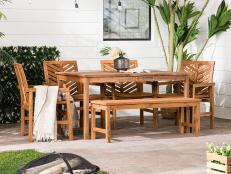Rewild a Garden and Help Make the Earth Healthy Again
Transform your outdoor space into a vibrant, eco-friendly haven that embraces nature.

Erik Meadows
Rewilding is a garden trend that aims to restore the planet to good health.

Manicured lawns and perfect gardens take constant work. If you stop mowing, your yard will become a weedy carpet. If you ignore your flowers or vegetable patch for a while, you'll have a bunch of dried-up, dying plants. Why not "rewild" instead?
Rewilding is a gardening trend that lets you off the hook for nonstop maintenance. You'll still have a role to play, but your plants, grasses and trees can thrive, and ecosystems will benefit when you use sustainable, regenerative practices and grow natives in your landscape and yard.
What is Rewilding?
Rewilding means letting nature take its course — at least, to some degree, says Brandy Hall, founder and CEO of Atlanta-based Shades of Green Permaculture. While traditional landscapes usually have neatly trimmed lawns and color-coordinated flowers, rewilding is about making space for wildness, she explains, although that doesn't mean your outdoor space has to look chaotic. It can be orderly enough to include what you need and want, like beautiful blooms or sunny spots for growing tomatoes. It also serves the needs of its non-human inhabitants, like songbirds that use trees for nesting or soil microbes that live on organic matter.
Why is Rewilding Your Garden Important?
"Wild nature is running out of space," says Kristine Tompkins, president and co-founder of Tompkins Conservation and former CEO of Patagonia, an outdoor gear and clothing company. "Human expansion has left very little room for the natural world, and it's struggling." To date, Kristine's organization and its partners have rewilded and expanded 15 national parks in Argentina and Chile. "If you believe that every living creature has intrinsic value, it's important to do what you can to make space for them. Of course, big, connected spaces are key to helping nature thrive in the long term, but restoring the habitat in your own backyard is a way that all of us can contribute to nature's wellbeing."
Rewilding a Northern California Garden 14 Photos
Learn more about the gardening movements of rewilding and regenerative gardening — and see them in action — in this year-long garden makeover from expert, author and homeowner Emily Murphy.
Many native species are threatened or disappearing. Brandy says a conventional landscape with two or three species of shrubs and trees may not support native flora and fauna unless the shrubs and trees are natives. In nature, ecosystems are more diverse.
Rewilding a lawn is important if you grow what Brandy calls a patchwork or polyculture of plants like dandelions, clover and different kinds of grasses. You'll help the environment by mowing less often, for example, and reducing the amount of undesirable emissions from gas mowers.
Instead of a lawn, diverse wild meadow species will sprout, she says, like pollinator-friendly clover. Clover helps make the soil more fertile by absorbing nitrogen from the atmosphere and turning it into nitrogen that other plants can use. That means you don't need as much artificial fertilizer. (If you have an HOA, Brandy suggests checking the rules before you make these kinds of changes to your lawn. If they only regulate what you can grow in your front yard, "your backyard is a good place to start.")
Before and After: Rewilded Front Yard

Before rewilding: The lawn and garden of this East Atlanta home had problems with standing water, mosquitoes and a lack of understory vegetation. Chickens ran everywhere, wreaking havoc on the plants.

Erik Meadows
After rewilding: Brandy Hall, founder and CEO of Atlanta-based Shades of Green Permaculture, says when nature moves in a certain direction, we can paddle with it or against it. Choose native and naturalized species and they'll usually thrive. Don't force plants into places they don't like.

Erik Meadows
After rewilding: Native plants, trees and shrubs offer niches and habitats for various species. The overall look is natural, yet structured.
Getting Started With Rewilding
Brandy looks at three "pillars" when planning a regenerative, sustainable and rewilded site: how water moves through the site, the kind of soil it has and what kind of plants it can support.
Any garden can be rewilded, she says. Start by identifying the flora and fauna —plants and animals — it already has. Look around you to see what's in the broader ecosystem. Then map out your site and decide whether you want medicinals, edibles or other kinds of plants. A rewilded garden or lawn will grow and evolve, so allow for changes. Watch out for invasive plants and reconsider what you think of as weeds, like dandelions or clover. Your goal is a balanced ecosystem.
Of course, big, connected spaces are key to helping nature thrive in the long term, but restoring the habitat in your own backyard is a way that all of us can contribute to nature's wellbeing."
Kristine Tompkins, President and Co-Founder of Tompkins Conservation and former CEO of Patagonia
Shades of Green Permaculture offers free and paid online resources about rewilding. Brandy also recommends reading Planting in a Post Wild World: Designing Plant Communities for Resilient Landscapes (Timber Press, 2015), by Thomas Rainer and Claudia West.
Choosing Native Plants for Rewilding
What native plants should you use? It depends on your growing conditions, Brandy says. Natives are usually better than cultivated plants because they've already adapted to where they are. They usually need less water and fertilizer, and some will have developed resistance to local pests and diseases.
Look for your plants at nurseries or garden centers that specialize in natives for your area. Drought-tolerant natives are good choices for a dry site or soil that's too sandy to hold moisture. Cardinal flowers, mints and grasses like Broomsedge are good natives for wet areas. Grow a variety of species and their diverse gene pool will help make your garden or lawn more resilient.
The National Wildlife Federation and the World Wildlife Foundation list native plants by region, or your nearest cooperative extension service may be able to help. Just don't dig natives from the wild; it's illegal to remove threatened or endangered natives. They may not survive being transplanted, anyway, and you will have disrupted their habitat.
Creating Habitats for Wildlife
Native plants will attract butterflies, birds and other wild creatures that live in your area, but you can also create habitats. Make a wildlife-friendly pond, a brush pile so songbirds can hide from hawks or a woodpile to shelter snakes.
Instead of thoroughly tidying up your garden at the end of the growing season, leave some plant stalks instead of cutting them down. Various native bees and other beneficial insects will use the hollow or spongy stems of faded flowers and grasses as winter habitat. Some species of newts, frogs and salamanders overwinter in piles of leaves or under logs and rocks. When the leaves decompose, they add nutrients and organic matter to the soil. Other ideas for adding habitats: erect bat houses or purple martin "condos" for these insect-eating birds. Brandy recommends letting birds and other wildlife dine on the seeds and fruits of your native plants, rather than birdseed.
Sustainable Garden Practices
Reducing or eliminating the use of chemicals and pesticides, recycling and composting, Brandy says, are vital in a sustainable space. Collect rain in rain barrels and direct heavy rainfall away from your home and paved areas to minimize the negative effects of stormwater and help prevent the soil from compacting. If you have a driveway or other surface that water can't pass through, replace it with a permeable surface.
Before and After: Rewilded Backyard

Before rewilding: Assess your outdoor space before you start. Notice how much sun and rainfall it gets, and understand what kind of soil you have.

Erik Meadows
After rewilding: A rewilded garden has something for all the inhabitants. Colorful flowers, chairs and ample shade let the humans enjoy the outdoors while a birdhouse invites birds to nest.

Erik Meadows
After rewilding: Water can soak into the soil through the pea gravel and between the stepping stones in this sustainable, regenerative landscape. Plants in raised beds are easy to see and tend.
Monitoring and Adapting Your Rewilding Efforts
It's a good idea to track changes in your lawn or garden's biodiversity so you can adapt your rewilding strategies if needed. The Great Southeast Pollinator Census records the kinds and numbers of pollinators seen across Georgia, South Carolina and North Carolina, which can help you plan your rewilded space. Do a little research to see if there are other programs or organizations that compile information on your state's native flora and fauna.
Want to engage with other rewilders for ideas and inspiration? Native plant societies in your area may be able to help, or you can get involved with National Audubon Society's Great Backyard Bird Count. An app called iNaturalist, available for Android and IOS, lets you share information about fireflies, moths, beetles, turtles and many other living organisms. Ask your extension service or the Department of Natural Resources in your state for other suggestions.
















































